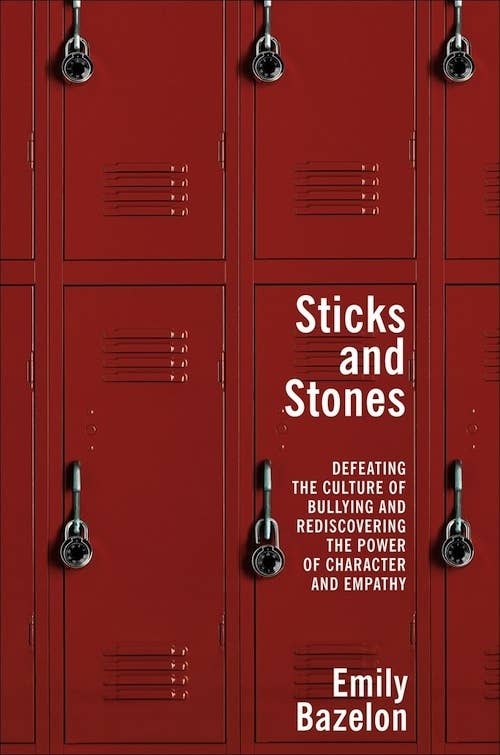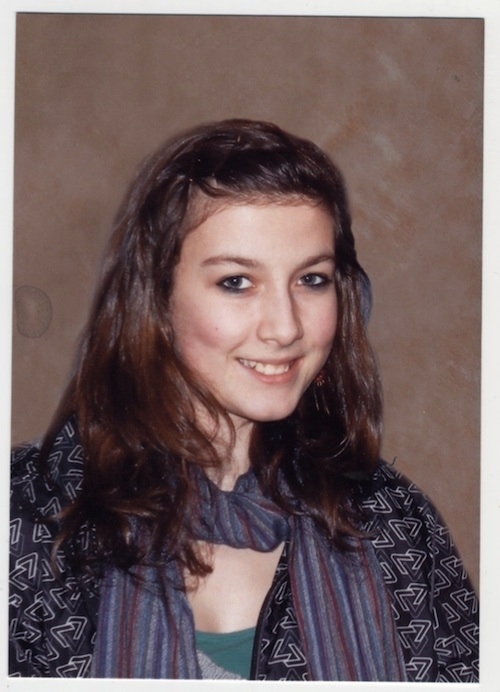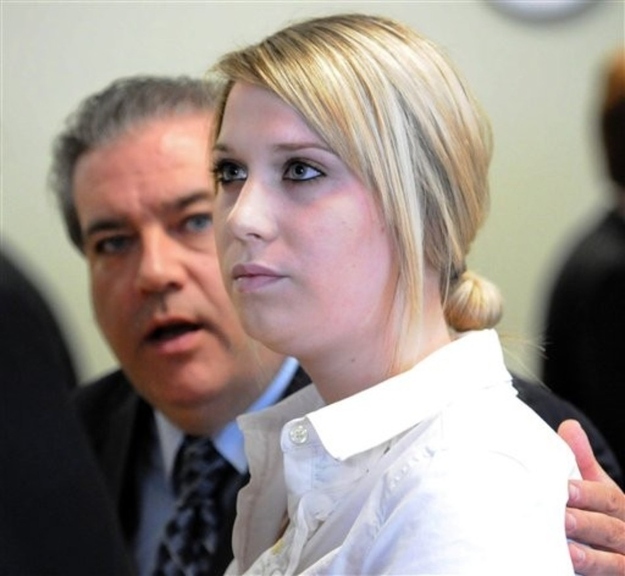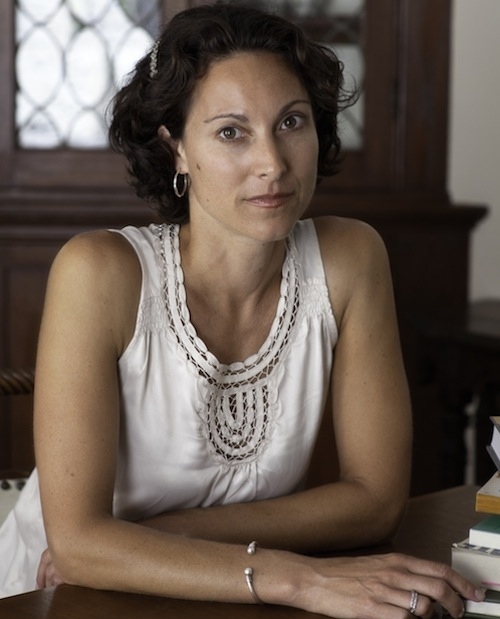
After 15-year-old Phoebe Prince of South Hadley, Massachusetts, committed suicide in 2010, six of her classmates (the "South Hadley Six") were essentially charged with bullying her to death. Emily Bazelon reported on the charges for Slate, and her just-released book Sticks and Stones takes a deeper look at Prince's story and at bullying in general.
The following is an exclusive excerpt from the book, focusing on Flannery Mullins, one of the South Hadley Six.
"I felt horrible that Phoebe died," Flannery told me, yet she also rebelled against the shame the media coverage suggested she was supposed to feel. She didn't defend Sharon and Ashley for calling Phoebe out as a slut, or Sean for encouraging it, but she didn't think she had bullied Phoebe, and she definitely didn't think she'd done anything to cause her death. What she thought, though, didn't matter. "I'd turn on the TV and there was this story about a girl who lived in a house with a white picket fence," she said. "We were the mean popular girls who just attacked her, and we weren't mad at our boyfriends at all — we just took it all out on Phoebe. She was the angel and we were the devils. I knew there were layers and layers of this girl, but no one would discuss any of that because they didn't want to blame the victim."
Flannery hadn't spoken to Phoebe in the week before her death. In fact, aside from their brief meeting in the assistant principal's office, after Flannery vented in gym class about her anger over Austin, she'd hardly talked to Phoebe at all. But the TV shows and the tabloids didn't care about the varying degrees of culpability from Ashley to Kayla to Sharon to Flannery. The media lumped the kids together as the "South Hadley Six," using their old yearbook photos instead of mug shots.
During the two-and-a-half-month-long investigation, Flannery never apologized to Phoebe's family because she didn't know what exactly to apologize for, and because she was trying to lie low rather than bring a new spike of attention to herself. None of the kids had said they were sorry — a fact that only deepened the distress and anger of Phoebe's family. Once district attorney Elizabeth Scheibel an- nounced the criminal charges in April, their lawyers advised them not to apologize, because they saw no way for the teenagers to take a share of responsibility without exposing themselves to legal risk. This is standard advice, but it made the kids seem heartless.
"If these charges hadn't been brought, it would have been a completely different situation," Flannery told me. "Maybe there would have been remorse. But they put me into a corner. I had to defend myself."
Scheibel had charged Flannery and Sharon, both sixteen, and Ashley, who was seventeen, as minors. But in an unusually aggressive move, the DA bypassed the privacy protections of juvenile court and made all six of the kids' names public. (Sean, Kayla, and Austin were indicted as adults.) And once they were named, the press had no compunction about hounding them. Reporters camped out on Flannery's lawn, making it almost impossible for her to go to work. One of her neighbors screamed "slut" and "whore" at her whenever she left the house, and started blogging about Flannery's movements. The household was under siege, and the stress strained the marriage of Flannery's mother, Jen. The public nature of the indictment "meant the end of our lives as we knew them," Jen told me. "People get indicted every day and you never hear about it, but Betsy Scheibel's mission was to smear these kids." Everywhere Flannery ventured where she met new people — parties, stores — she faced questions and denunciations, with people assuming her guilt and her responsibility for Phoebe's suicide. "It was like a runaway freight train," Jen said.
Flannery's lawyers tried to reassure her and her mother that the case against her was full of holes. For starters, the most serious felony charge — civil rights violation with bodily injury — required an act or threat of force, and Flannery's remark in gym class that "someone should kick [Phoebe's] ass" was a stretch. For another, the causal connection between anything Flannery had done and Phoebe's death was, to say the least, attenuated. Still, the lawyers cautioned Flannery against talking to Austin or seeing him. Isolated and living under a kind of media-imposed house arrest, Flannery was touchy and antsy. She felt as though her whole existence was about being under indictment — and it was impossible to imagine returning to normal.

The next day it was Flannery's turn. She appeared before a different judge, with Sharon and Ashley, at the smaller, humbler juvenile courthouse in Hadley, one town over. Flannery had struggled over whether to accept her plea deal. She thought about daring the prosecution to take her case to trial. "I thought, let them try," she said.
But that would have meant months, or even years, with serious criminal charges hanging over her head. Flannery had turned eighteen, and it was time to move on, to look ahead, to stop reliving the upheaval that split her life in two: before and after. She agreed to admit to what she'd said about Phoebe, about how "someone ought to kick her ass," the basis for the charge that she'd disturbed a school assembly, that is, her gym class. In a strained resolution of the civil rights charge, Flannery also took responsibility for Sharon's misconduct — calling Phoebe a whore at school — even though Sharon said from start to finish that she'd done this on her own. In exchange, Flannery would get probation and community service with the understanding Kayla had: once she completed her sentence, her record would be clean. Ashley and Sharon got the same kind of deal. Austin fared even better: the statutory rape charge against him was dropped.
At the hearing, Flannery wore a white oxford shirt, the collar crisp at the fold, and her blond hair coiled into a bun. The lawyers dispensed with the preliminaries, and Anne O'Brien rose to speak again. "Phoebe had as much right as Flannery Mullins to be in school," she said, reading from her notes. "She was an intelligent student with a promise of high achievement. She loved her accelerated English class and having her own blog to share her writing. Phoebe loved her history class. . . . She loved the challenge of her Latin class and was in awe of her teacher's intelligence. . . . Yet with Flannery Mullins' very numerous threats to beat her up, school for Phoebe became intolerable. In her words, it was not a place of solace and intellectual challenge, but simply a challenge to make it through each day without coming to harm."
Flannery was looking straight ahead, her features unmoving, betraying nothing. O'Brien kept going. "Flannery Mullins used her time in school to berate Phoebe in corridors and in the classroom. . . . When she was brought before school officials to address her actions, she took no ownership of them, and placed the blame on Phoebe. . . . She followed her into the bathrooms, the hallways and classrooms of the high school. Phoebe soldiered on, struggling to get through each day, hoping the next would be better. Phoebe drew a sketch on one of the folders I keep my school papers in, of a candle with a flame. And underneath she'd written, 'There is always a light.'" Anne's voice broke as she turned to look at Flannery. "Phoebe tried to be strong but sometimes people want nothing more than to break you."
Anne paused, but she wasn't finished.
"Phoebe ended her pain, brought about by the harassment of many, including Flannery Mullins, harassment that could easily have been stopped if any of those involved had ever reached inside themselves to find their own compassion. I have not yet buried Phoebe's ashes. I've been waiting for peace to do so. I know now today it may never come. So I will return home and bury my daughter. With her qualities of compassion, empathy, and zest for life, Phoebe gave me some of the happiest moments of my life. My pain is unbearable and it will stay with me until my own death and I would not wish this pain on any parent."

In this wrenching torrent, Anne had again claimed her right, as a mother in mourning, to go beyond the facts in the record. No one dared question her judgment in doing so.
But it was hard for Flannery to swallow her defiance. She knew Phoebe's mother had suffered, but she couldn't accept Anne's narrative of her daughter's death. "Everyone said I was heartless because I wasn't crying in court, but in my mind, I didn't do anything," she told me later. "Of course it's so sad Phoebe died, but her mother screaming at me, telling me it's my fault — I thought that was extremely immature. I know that's horrible to say."
I asked if she'd thought about changing her name or moving away from western Massachusetts, and Flannery shook her head. "I'm not ashamed," she said. "I have no problem defending myself. I don't want to be ashamed. I think it would be harder for me if I sat down and was like, 'I'll change my name, and I'll move, and no one will know me.' No. If you have a problem with me, you can tell me, and I can explain that it's not the truth. If people are ever going to digest the real story, they have to accept the fact that the picture of Phoebe that was painted isn't true." Flannery knew that the tragedy of Phoebe's suicide made that extremely difficult to do, but she was holding fiercely to her reality.
The relationship between bullying and suicide turns out to be complicated. It's true that there's an association between the two, for both girls and boys: studies show that kids who are bullied are also more likely to think about or try suicide. The link is especially strong for gay kids.

Whether bullying predicts suicide, however, is a separate inquiry. It's a chicken-and-egg question: are kids who are involved with bullying more likely to be suicidal in the first place, or does the experience of victimization place them more at risk? For kids who experience school-age bullying, the research is mixed. Finnish and Australian studies found that bullying didn't predict depression or attempted suicide once a child's prior mental health was taken into account — in other words, when children were bullied, they didn't become more likely than they otherwise would have been to develop, as teenagers, the symptoms of depression that are the biggest risk for suicide. On the other hand, a study of Norwegian eleven-year-olds by Dan Olweus, and another study of Korean seventh and eighth graders, found that bullying did predict depression and attempted suicide. Still another Finnish study of eight-year-olds who were bullied, and then followed up ten years later, showed the results varying by gender: among girls, frequent victimization was associated with later suicide attempts even when controlling for depression, whereas for boys the same was not true.
The upshot is that there is some reason to think that childhood bullying, on its own, elevates the risk of depression and suicide, but the picture isn't yet clear.
And it's even less clear for kids who are bullied in high school. In a recent study of whether bullying at this older age predicts suicide attempts — the only one of its kind I could find — Columbia psychiatrist Madelyn Gould and a team of researchers tracked three groups of teenagers. At an initial screening, the first group, which totaled 221 students, reported suicidal behavior or thinking, depression, or substance abuse. The second group, with ninety-six students, had the same psychological profile and also had been involved in bullying. The third group of 236 had been involved in bullying but were not depressed, suicidal, or substance abusers.
Four years later, Gould's team went back and interviewed the same teenagers. On average, the 236 young adults who'd experienced bullying but did not have the at-risk psychological profile were less likely to be suicidal than the young adults who did, whether they were bullied or not. "Involvement in bullying behavior (as a bully, a victim, or both) in the absence of other risks in high school did not predict later depression, suicidal ideation, or suicide attempts," Gould and her colleagues wrote.
Gould calls for more research, but she is adamant that it's wrong to attribute any one suicide entirely to bullying, as media accounts often do. "The problem with saying bullying caused a suicide is that it oversimplifies," she told me. "It implies that one person's death by suicide can be attributed to one event or factor, which is just not true." She sees these "bullycide" narratives as part of a longstanding mis- guided pattern. "We've singled out different scapegoats for suicide for decades," she said. "We blamed the mean teacher. Or the bad parents. Or Dungeons and Dragons, or working mothers, or divorce. Now it's bullies, and especially mean kids on the Internet. The thing is, there can be some truth to these explanations. When someone is vulnerable, and then they experience what we call a stressor event, and they are humiliated, that can be terrible for them. But it's crucial to remember that what we're also seeing as these narratives take shape is our underlying need to try to understand an event that family members and friends find so inexplicable."
It's imperative not to blame families for the current fixation on bullycide. This is something that Michele Dauber, a Stanford law professor whose daughter took her own life at twenty-five after a long struggle with depression, impressed upon me during a conversation over the course of several weeks. Dauber reminded me of an arresting image in the Harry Potter books: because they have seen death, Harry and a friend, Luna Lovegood, can see a winged, skeletal horse, called a Thestral, that's not visible to anyone else. This is Dauber's metaphor for being a parent who has lost a child. "I'm different from you," she told me. "Because I now understand that nothing is promised. Good things aren't a reward and bad things aren't a punishment. There is nothing we can do to avoid tragedy — sometimes it just comes, and when it does, the world is no longer a benign place full of excitement to look forward to, or even a place where we go to work and put food on the table, but a terrible, miserable slog in which one by one everyone we love goes away forever, unless we die first. That is what being the parent of a dead child is like. So how can we blame these poor people if they aren't seeing things the way we think they should?"
From the Book, STICKS AND STONES by Emily Bazelon. Copyright (c) 2013 by Emily Bazelon. Reprinted by arrangement with Random House. All rights reserved.

